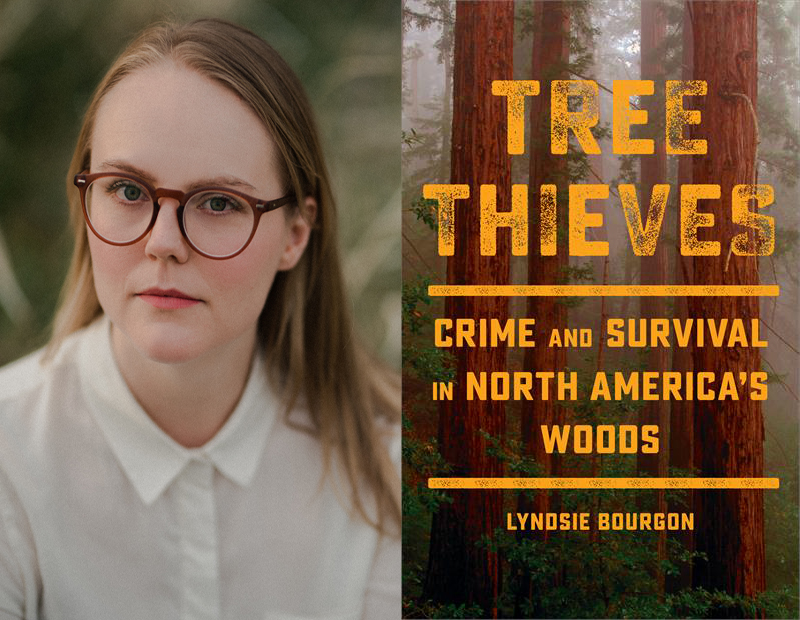To someone brought up on the dry, flat, windblown prairies of Southern Alberta, the damp and fecund old-growth forests of British Columbia symbolize a mythical, misty past. So, in 2012, when Albertan Lyndsie Bourgon first heard of the illegal felling of an 800-year-old red cedar in Ditidaht territory on Vancouver Island, she says, “It really shocked me.” Floorboards and firewood? What an ignoble end!
The event – as senseless as killing an animal for its ivory or horn – spurred Bourgon (a 2018 National Geographic Explorer) to begin reporting on the increasing spate of tree poaching sweeping the Pacific Northwest, Alaska, and deep into the United States. This in turn led to Tree Thieves: Crime and Survival in North America’s Woods, a scrupulously researched nonfiction work exploring conservation history and how the natural world defines us. The ghost of that ancient redwood haunts the book throughout. “I wonder how someone who lives surrounded by the crushing beauty of a redwood forest can simultaneously love it and kill it; can see themselves so entwined with the natural world that destroying part of it comes to feel like another stage in its life cycle,” writes Bourgon.
Published this month by Vancouver’s Greystone Books, Tree Thieves lays out startling statistics: $1 billion worth of trees are poached yearly in North America, many of them from public lands. In B.C., where Bourgon now lives, $20 million in poached timber is felled yearly from publicly managed forests. (The global estimate for black market logging is upward of $157 billion annually.) This massacre is being committed by large corporations and individual operators whose fathers and grandfathers were proud forestry workers, as well as small-time crooks motivated by greed and the unlikelihood of getting caught. Unfortunately, as Bourgon points out, timber poaching cases are notoriously difficult to prosecute: perpetrators don’t leave fingerprints on tree-stumps.
Tree Thieves is divided into three parts, starting with “Roots,” which details the history of tree poaching. The other sections explore the decades of government irresponsibility that allowed such travesties as clear-cutting and led to the acrimonious War in the Woods in Clayoquot Sound in the 1990s that pitted conservationists against forestry workers who saw their livelihoods disappearing. It could have been easy for Bourgon to craft a polemic and side with the conservationists – their mandate parallels Tree Thieves’ urgent message to save North American forests from illegal, indiscriminate cutting. Bourgon, however, is impartial and even sympathetic toward those whose lives were once centred around tree-cutting. Her empathetic narrative shows how the woods are entangled in the blood and bones of the foresters turned poachers whose forefathers raised families and built towns on the back of forestry. Poaching, writes Bourgon, is a complex crime that must be understood within a cultural context, and prevention must address the socio-economic factors that cause it. Losing one’s livelihood due to increasingly strict conservation policies is a slap in the face to those whose identity is tied to forestry. “Timber poaching is a large, physical crash of a crime, and it is rooted in a challenge that stretches across North America: the disintegration of community in the face of economic and cultural change.
Part of Bourgon’s objective in writing the book is to call for an end to the bitterness between conservationists and forestry workers turned poachers. Ironically, these two factions have the same goal: a healthy, growing forest. The inability to coordinate is rooted in “heated rhetoric,” Bourgon says. Nasty name-calling on social media isn’t a good foundation for constructive public policy, which requires collaboration from all concerned parties. “Poachers see people talking about them online and then the anger deepens. People don’t forget how people have spoken to them and treated them,” Bourgon says. “For me, on a personal level, this has really guided what I hope will happen.”
Corporations must take much of the blame. “Industry has failed to recognize the need for a more sustainable harvest that could ensure sustainable livelihoods. Corporations pushed for bigger bottom lines and massive growths in profit,” she says.
Blame also lies with insatiable consumer demand. Illegally sourced wood is sold to Chinese manufacturers who churn out napkins, food packaging, construction materials, flooring, and furniture that is sold at places like Home Depot and Ikea. (In the Amazon, 80 per cent of harvested wood is poached; in Cambodia, it is 90 per cent.) If you buy firewood on Kijiji or Facebook Marketplace in Washington State or B.C. you may well be buying poached wood. The message is clear: we as individuals bear some responsibility for tree poaching, and thus bear some responsibility for helping to stop it.
Bourgon’s engrossing narrative is a clear analysis not only of the socio-economic effects but also the ecological crisis tree poaching presents. Trees, especially old-growth, are crucial to the survival of a raft of living creatures, such as nesting bald eagles and other birds, and are a counter to worsening climate change. Trees like coastal redwoods store water in their roots, preventing riparian zones from drying out. Even in drought, decaying logs provide water to thirsty forest organisms, writes Bourgon.
Tree Thieves is a gut punch that will leave the reader angry, frustrated, and deeply saddened at the forest carnage perpetrated by human greed. It should inspire consumers to support national and international efforts to stop tree poaching and the razing of forests.
Bourgon offers us an answer to the eternal question: if a tree falls in the forest, does anybody hear? The reverberations are heard and felt by everyone and everything.
Lyndsie Bourgon: Stacy Krolow

 Contact us via email
Contact us via email

